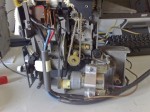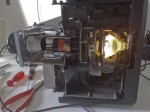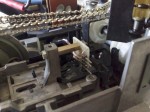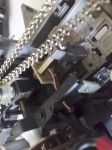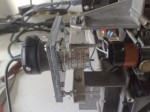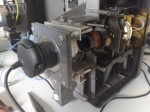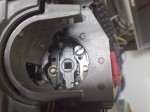To build my own Telecine machine I had a Bolex 102 MTC projector available. After reading several articles from other people who made their own telecine machines (you can find them easily on the web), we have the following list of modification to make on the projector:
- Slow down the frame rate so we can capture the projected frames with a simple camera.
- Replace the halogen light by a LED light, this saves heat and reduces the brightness.
- Remove the shutter and frame rate select mechanics.
- Add a trigger so we can capture the projected frames.
- Change lenses and add a camera.
Note that this is not a manual how to build your own telecine but it are just some notes to show what you need to do to make one yourself.
Slow down the frame rate.
I started to replace the AC motor by a 18 Volt DC motor with a gearbox. The original belt wheel fitted on this motor. Now the projector runs at about 1.5 frames per second.
On this picture, two of the three shutter blades are removed, in the end I removed them all. Without shutter blades the projection light is continuous via the film on the camera so that any auto regulating light sensitivity software gets a more or less steady light intensity. Any software that tries auto correction will then not disturb our work.
Then there was also some nifty mechanical logic that controlled the actual projection speed. If the projector was for example set to project at 12 fps, that logic would let the transport forks advance the film only 2 out of 3 times. By removing this makes enough free room to place a trigger for our sync pulses.
New LED light.
The old 100 Watt halogen light is replaced by a 12 volt 3 watts LED light. This light is still to bright for our purpose, but the current of this light can easy be regulated with a simple dimmer circuit. I left the diffuser in place that normally only was shifted between the light and film if the frame rate was set below 18 fps. I think this was to prevent burning the film at lower speeds, but I found that it softened the light somewhat. After a small modification the diffuser is now permanent in place.
Add a frame trigger.
In a local shop I bought the ITR8102 opto interrupter and placed it on a small circuit board with a connector. That connector fits a computer CD drive audio cable that will be used to connect to the rest of the electronics. The interrupter is placed so that a tab of the film transport shifts in the light slot when the film is moved to the next frame.
Lens and camera.
This costs the most time to figure out. It depends on what you have and how much money you want to spend. I had a cheap Philips web cam (Microsoft branded), and some sets of old camera lenses. I ended with an old surveillance camera lens connected to the web cam, but without the original web cam lens. From the original lens system I removed the outer lens and found that if the new build camera was in the right place I could get a sharp picture. The camera can be adjusted with long M4 screws. Later I found out that this is absolutely needed to adjust between super 8 and normal 8 films.
Over the original black lens pipe, I later glued a piece of drain pipe to fill the gap between the camera and original lens.
Unplanned modification.
The last modification is that I widened the film hole to the same size as the sled. The camera can then capture the image plus the frame borders. The stabilizing software for the film restoration will have then more room to work with. Most other people have done this with better results then with the original window size.
This completes the mechanical work, next the electronics.
